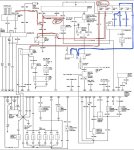ylidk
Member
- Joined
- Jul 16, 2018
- Messages
- 52
- Reaction score
- 7
- Points
- 8
- Location
- KS
- Vehicle Year
- 1991
- Make / Model
- Ford
- Engine Size
- 2.3l L4
- Transmission
- Manual
Hey all, so this is going to sound like the obvious answer is a bad voltage regulator, but it has been far more confusing of a problem and I finally decided to stop and ask for some help.
I have a 1991 ranger that came with the 2.3 stock. I have swapped the engine for the 2.3 turbo from an 88 turbocoupe, and a fair bit of wiring has changed around, but I am using the belt drive from the ranger so the alternator wiring is (was) stock (see attached image with lines highlighted blue). At the alternator power output, I saw 14 volts, but the battery only charged up to 12.5 volts. The 14 volts persisted at the power distribution box and through the maxi fuses, but dropped 0.5 - 1.0 volts at the starter solenoid, then another 0.5 to 1.0 volts to the battery.
I tried cleaning contacts, and fixing this in any way I could, but eventually gave up on the power distribution box for the alternator power, cut those wires and used fusible links routed directly to the battery terminals, so now that alternator goes directly to the battery. The power distribution box still gets power from the battery of course, and the alternator's voltage regulator reference wire still goes to the fuse here, as the voltage matches what the battery says and I don't see a need to reroute this one.
After making this change, now the alternator power output only reads 12.5V (at least it matches the battery this time) and won't put out 14 volts. Here's where the issue seems like a bad voltage regulator, but I have swapped the alternator and had the same issue with this one. I drove the car to Oreillys, and both alternators failed on the car, yet the original alternator passed on the tester. The replacement (duralast gold) actually failed on the machine, but they had to macgyver some jumpers between the new alternator's hard wired lines and their plug connector, so that could be the cause here.
I've checked resistance between battery terminals while the engine is running and get 27 ohms, which matches my f150 while running as a baseline, so I don't think there is a short somewhere causing this issue. I have swapped batteries with the f150 and still no luck, 12.5V in the ranger and 14 volts on the Rangers battery in the f150.
At this point I really have no idea what could be causing it, as every test has pointed to a bad alternator, except the alternator tests good. I am getting the duralast replaced, but they have to order in the replacement, so hopefully that is actually the cause, but the currently installed alternator should be working.
Any help is appreciated, this has been driving me mad for almost a week now.
I have a 1991 ranger that came with the 2.3 stock. I have swapped the engine for the 2.3 turbo from an 88 turbocoupe, and a fair bit of wiring has changed around, but I am using the belt drive from the ranger so the alternator wiring is (was) stock (see attached image with lines highlighted blue). At the alternator power output, I saw 14 volts, but the battery only charged up to 12.5 volts. The 14 volts persisted at the power distribution box and through the maxi fuses, but dropped 0.5 - 1.0 volts at the starter solenoid, then another 0.5 to 1.0 volts to the battery.
I tried cleaning contacts, and fixing this in any way I could, but eventually gave up on the power distribution box for the alternator power, cut those wires and used fusible links routed directly to the battery terminals, so now that alternator goes directly to the battery. The power distribution box still gets power from the battery of course, and the alternator's voltage regulator reference wire still goes to the fuse here, as the voltage matches what the battery says and I don't see a need to reroute this one.
After making this change, now the alternator power output only reads 12.5V (at least it matches the battery this time) and won't put out 14 volts. Here's where the issue seems like a bad voltage regulator, but I have swapped the alternator and had the same issue with this one. I drove the car to Oreillys, and both alternators failed on the car, yet the original alternator passed on the tester. The replacement (duralast gold) actually failed on the machine, but they had to macgyver some jumpers between the new alternator's hard wired lines and their plug connector, so that could be the cause here.
I've checked resistance between battery terminals while the engine is running and get 27 ohms, which matches my f150 while running as a baseline, so I don't think there is a short somewhere causing this issue. I have swapped batteries with the f150 and still no luck, 12.5V in the ranger and 14 volts on the Rangers battery in the f150.
At this point I really have no idea what could be causing it, as every test has pointed to a bad alternator, except the alternator tests good. I am getting the duralast replaced, but they have to order in the replacement, so hopefully that is actually the cause, but the currently installed alternator should be working.
Any help is appreciated, this has been driving me mad for almost a week now.
Attachments
-
159.3 KB Views: 30
Last edited:















